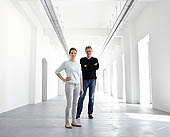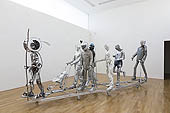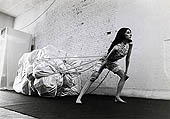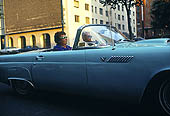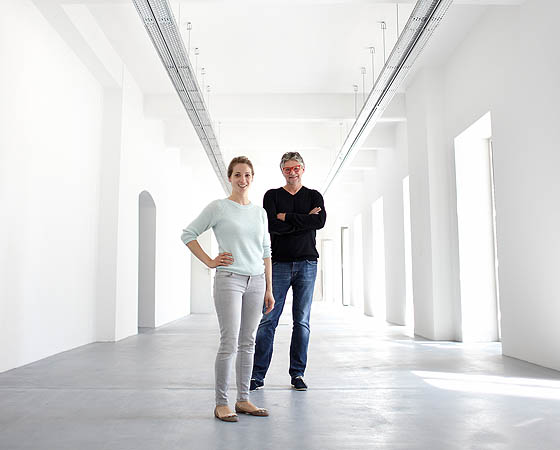
translated and summarized by: Liz Wollner-Grandville,
English summaries August 13 - 26
Ostlicht
Night
05.06.12 – 29.09.12
By Manisha Jothady
Three years ago, gallery owner Ernst Hilger established the BROTkunsthalle in the former Anker bread factory in Vienna’s Favoriten district. This June, Peter Coeln, founder of the WestLicht photo now opened the OstLicht photo museum in the BROTkunsthalle, which is located away from the usual downtown art bustle. Gregor Eichinger transformed the 800 square meters of the OstLicht into a gallery and a publicly accessible library. The location is meant to serve as both a mediating platform as well as a sales platform for contemporary art photography. Occasional exhibitions in the WestLicht provided insight into art photography of the younger generation. However, due to the institution’s concept of prioritizing historic and documentary photography as well as camera auctions, it was difficult to integrate young photography. The founding of OstLicht now provides an opportunity for a more stringent focus.
Peter Coeln and OstLicht-manager Verena Kaspar Eisert opened the new venue with the exhibition “Night”. Eighteen positions elaborate on an extensively repeatedly topic in many different ways. Nieves Widauer’s “Moonlight photographs” are characterized by their impressionistic, artistic quality, while Gregor Sailer’s works are more graphic and were produced with his self-made Camera Obscura. Both Hans Kuppelwieser’s photograms as well as Tatiana Lecomte’s photographs - the latter are based on templates from astronomy books – lose themselves in a seemingly realistic spangled sky. But the night is not only filled with poetry: Katrina Daschner’s and Borjana Ventzislavova’s works depict images of sexual violence and prostitution. Peter Riedler took shots of St. Petersburg's famous “White Nights” in various discos throughout the Russian city. Despite the title of the exhibition, none of the presented works convey a simplistic effect. To a good part this is mainly due to conceptual works such as those by Anita Witek. Her C-prints are based on collages that suggest spatiality and differing lighting conditions. “Night” is merely one association among many.
OstLicht
1100 Vienna, Absberggasse 27
Tel.: +43 1 996 20 66
Fax: +43 1 996 20 66 – 66
email: info@ostlicht.at
www.ostlicht.at
Sammlung Goetz
Pawel Althamer
29.05.2012 – 06.10.2012
By Stephan Maier
At the opening, members of Pawel Althamer’s “Task Force” stepped out of the fancifully designed “Magical Mystery Tour” bus in their golden astronaut overalls and immediately mingled with the other guests. Althamer’s “community” - accompanying him to every exhibition and made up of his friends, neighbours and relatives - didn’t do much, but, more important, the group didn’t leave the unpleasant impression of wanting to stimulate the others – and that’s a good thing.
This allowed for an undisrupted impression of the Polish artist’s oeuvre of the Goetz Collection. Too often did the group dynamic efforts by Althamer, who always attempts to overcome the hopelessly out-dated understanding of art, overshadow his actual work. No matter if he organized an “Illustrator Conference” like the one at this year’s Berlin Biennial or if he initiated projects with prisoners or youths: it always had to do with the participation of social outsiders and the “spiritual journey” of the author.
The magic-psychedelic character of his works are evident in their calling for attention to the conditions of the aggregates of human character on the quasi religious quest of itself, the other, and the rest. The self-portrait of a wormlike embryo with a head resembling that of a surreal shrunken adult'sis touching. The totemic terracotta statue of his wife, big with child, created as a double portrait of mother and son, is brilliant. And the collective effort with Polish students culminates in a realistic sculpture of a homeless person, who seems to contemplate about the one-way paths of life.
The show is dominated by the dimension and complexity of the completely aloof group of figures of the “Bródno People” that Althamer realized with neighbours from the Brodno prefab building estate in Warsaw. Almost incidentally Rodin’s “Citizens of Calais” and its epitome of civil solidarity seem to be catapulted into an apparent unreal present and counter-world. On the moveable constructions the futuristic parade of fools including figures such as Teletubby and Cyborg, astronaut and alien, pass the onlooker at a distance like a group of visitors. A figure resembling Picasso’s “Woman with the baby carriage” encounters the chaotically arranged bulk trash-chic of Eastern European everyday life.
On the other hand, the image of the young mother pushing a stroller in the everyday ghetto-life of East and West is an extremely familiar one. In this context, members of marginalized groups such as Südtirolerplatz-Günther (exhibition in the Secession) would have been too otherworldly-alien: in Munich, even the sellers of the street papers are inconspicuous, but conspicuously neatly dressed.
Sammlung Goetz
8192 Munich, Oberföhringer Strasse 103
www.sammlung-goetz.de
MUMOK Museum moderner Kunst
Reflecting Fashion – Art and Fashion since Modernism
15.06.12 – 29.09.12
By Daniela Gregori
At the opening, the director appeared in a stylistically perfect Mondrian-Look, a classic outfit with which Yves St. Laurent caused a stir in the 1960’s. One might attest this to be a confirmatory comment on an exhibition interacting between art and fashion.
“Fashion”, says Barbara Vinken, literary scholar and fashion theoretician “is a statement in clothes about clothes”. But fashion is also the matter-of-course interface between fashion and everyday life – both reciprocally commenting on one another. In Vienna, around 1900, the dream was already dreamed about the penetration of art and life - and, similar to Germany and Henry van de Velde, artists in Austria such as Kolo Moser, primarily dealt with so-called reform dresses for domestic use. In contrast, Emilie Flöge created both representative as well as programmatic designs. That her couture was mentioned in a German magazine together with Gustav Klimt said a lot about their teamwork - both in theory and in practice.
But there was also this kind of convergence and reciprocity with fine arts in other cultural domains such as architecture, literature, theatre, film, and design. Yet fashion appears as the most valid, possibly even the most multifaceted of these combinations. Constructivism positioned bodies into the most differing colourful forms, and in Surrealism there was a wonderful encounter of a lobster and an evening dress – Elsa Schiaparelli had teamed up with Master Dali. In Regina Möller’s or Sylvie Fleury’s works biographical aspects come into play, and socio-critical positions appear in Christos “Wedding dress” with its apparently extremely heavy and tied up train or in VALIE EXPORT’s genital panic trousers.
This exhibition has nothing to do with luxury, labels and passion – staged opulently or in any other way – or other fashion phenomena but only with fashion, art and their reflection. Not more, not less, not dolled up - actually classic and therefore more intellectual than sensual.
Can an exhibition such as this one be too full? No question: one can approach the topic as rational as possible, but who doesn’t lament about having a wardrobe full of nothing to wear? Here, there is not one piece too much, and certainly not a classic.
MUMOK Museum moderner Kunst
1070 Vienna, Museumsquartier, Museumsplatz 1
Tel: +43 1 52 500
Fax: +43 1 52 500 13 00
Email: info@mumok.at
www.mumok.at
Opening hours: Daily from 10.00 hours to 18.00 hours, Thu from 10.00 to 20.00 hours.
Albertina
Joel Sternfeld – Colour photography since 1970
27.06.12 - 07.10.12
By Manisha Jothady
Walker Evans once defined colour photography as "vulgar", and even in 1980, Roland Barthes described it as "unnecessary maquillage"" that hides the true traces of a photographic picture. Colour as a photographic stylistic device was banned for a long time in the domains of promotional and amateur photography. Then in the 70's, colour photography was finally acknowledged in the USA as a form of art. This aesthetic emancipation process was set in motion by those photographers who delighted in experimenting, who wanted to discover how the American way of life was mirrored in photographs of people, landscapes and cities. Besides William Eggleston, it was the five years younger Joel Sternfeld, amongst others, who advanced to become an important representative of the so-called New Colour Photography. Eleven of his series, created between the early 70's and 2007, have been exhibited for approximately one year throughout Europe. Following Essen, Amsterdam and Berlin, they have now arrived at the Albertina. The focal point is the, thus far not exhibited, early work of the artist with the series “Nags Head”, “Happy Anniversary Sweetie Face!” and “Rush Hour”. While the "decisive moment" of Cartier-Bresson's and Eggleston's gaudy colourfulness shine through here as examples, Sternfeld developed his own autonomous picture language later on with “American Prospect” (1979-1983). One can hardly believe that a photograph - such as that of the fire fighter in orange-coloured protection gear who is looking at orange-coloured pumpkins completely calmly whilst in the background of the picture, a house is burning – is not the result of having been staged.
Sternfeld's interest does not only lie in such curious events, which are always waiting around the corner in life. In the series such as "Stranger Passing" (as of 1987), he focuses on socio-typological topics. In "Walking The High Line" (2000-2001) and "Oxbow Archive" (2005-2007), he targets the relationship between nature and culture. A conceptual approach to documentary photography is revealed in the series "On This Site" (1993-96). It is only through the accompanying text that one learns what atrocities have been carried out in the uninhabited sites."Sweet Earth" (2006) also indicates the interconnection of picture and text, a series about alternative communities. The genial play with colour, as well as the absurdities in everyday life, which is as defining for the early work as for his Opus Magnum "American Prospect", has given way here to a politically motivated, aesthetically somewhat brittle concept. Unfortunately.
Albertina
1010 Vienna, Albertinaplatz 1
Tel: +43 1 534 83 -0
Fax: +43 1 533 76 97
E-mail: info@albertina.at
www.albertina.at
Mehr Texte von translated and summarized by: Liz Wollner-Grandville


 Teilen
Teilen

